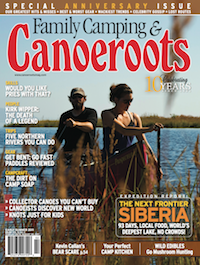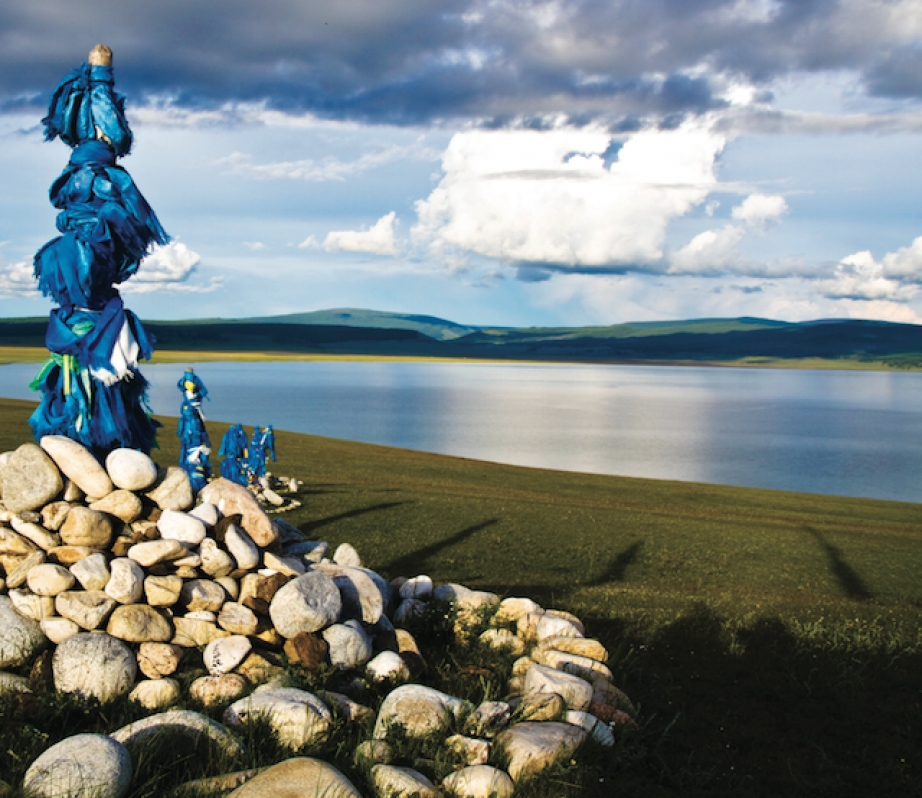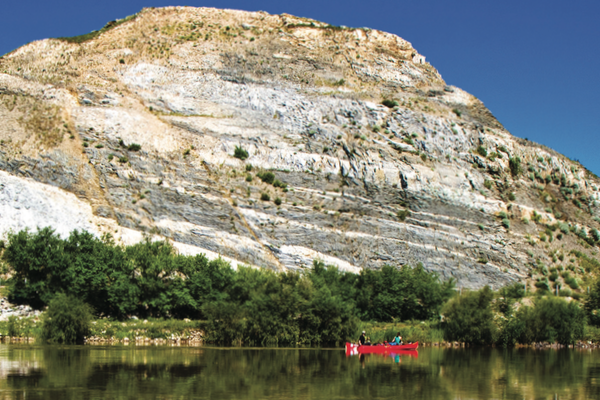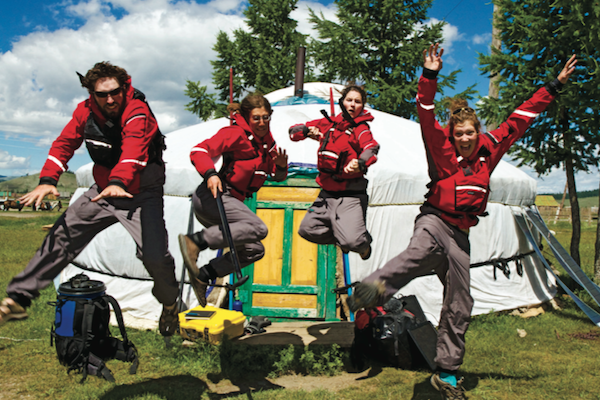From the riverbank, a family motioned for us to pull ashore. The mother, father, two teens and kid brother regarded us curiously. Their jean shorts and Nike t-shirts contrasted with the landscape behind them, a boundless expanse of forest, steppe and mountains rambling off to the horizon.
I glanced back at Eric on the stern seat. “Might as well go say hello,” he said, steering our heavily laden canoe toward shore. Ulysse and Elsa followed in the second canoe. Pulling ashore, we exchanged greetings, “Sain bainuu”—Mongolian for, hello. When we asked what they were doing, the family showed us a large pail filled with red currants and pointed toward the forest. We presented our own small bag of sad-looking berries that we had picked a couple days before.
The game of show-and-tell continued as the family matriarch unwrapped a newspaper containing five plump fish. Again, we displayed our modest catch: a six-inch fish that Eric had reeled in hours before. Surprisingly, it was the first fish of our trip.
Half a year prior, preparations for our three-month journey through Mongolia and Russia had included shipping canoes, applying for visas, navigating a labyrinth of logistics and learning useful phrases in not one, but two languages. We scrounged for what little information existed on the route’s rivers and lakes. Among our research was rumor of the region’s piscine delicacies.
In Ulaan Baatar, Mongolia’s capital, we packed our food and purchased a few last pieces of gear. Back from shopping, Ulysse proudly showed me his two fishing rods and exclaimed,
“We will eat fish every night!”
His bearded face glowed beneath a hat that was stitched with the words, Serious fish. He had even brought along all the ingredients required to make sushi.
From Ulaan Baatar, we drove for three days over unmarked, rough tracts in an overloaded Chinese van. After getting stuck in a bog for five hours, our driver motioned he could go no further. We portaged and paddled the last 70 kilometers to the northern tip of Lake Khovsgol in far northwestern Mongolia.
From Khovsgol we could see the serrated peaks that formed the Russian border. Our destination, Lake Baikal, was just 200 kilometers east as the lammergeier flies, but we were following the natural flow of the water on a meandering, 2,000-kilometer semi-circle through the steppe and taiga forest.
Khovsgol was nicknamed “the blue pearl” for its pristine, turquoise water—so clear that we could see the fish swim up to our hooks, and right on past. Situated in a transition zone between Siberian taiga and Central Asian steppe, the lake area is protected as a national park larger than Yellowstone. Rolling hills silhouetted the eastern horizon, while the high mountains on the opposite shore still carried snow.
The environment created dramatic weather patterns: in the morning we enjoyed warm July sunshine, but the afternoon skies frequently turned dark and stormy. We spent a week paddling 126 kilometers south to the lake’s major outflow, the Eg River.
We arrived at the Eg to find the river in full flood.
The narrow, braided channels caused more difficulties than we had expected. Strainers—fallen trees through which the stiff current flowed heedlessly—hid around every corner. Often just six meters wide, the river sometimes whipped us around a bend only to find a tangle of branches completely blocking our path. Our 17-foot canoes dumped and pinned on several occasions. Fishing rods lay forgotten at the bottom of the canoes as we focused instead on paddling 40–50 kilometers a day. The Eg, and the Selenge River into which it flowed, were hailed for their world-class sport fishing. Native taimen, members of the salmon family, grew up to 1.5 meters long and weighed up to 50 kilograms, making them some of the world’s biggest freshwater fish.
We didn’t see any elusive taimen in the Eg, or downstream in the equally murky Selenge. Where the rivers met, however, we remembered a local fisherman’s advice: “The best place to fish is at the confluence of two rivers.” Seizing the opportunity, Eric cast a line into the water and was rewarded with a bite. Not a giant taimen, but our hoots and hollers could be heard from miles away as he reeled in our first catch.
It is just a few hours later that we meet the Mongolian family. It’s not our first encounter with the locals who live along the riverbanks. A couple days earlier we had helped a sick man, his family and two doctors across the river to an ambulance waiting on the other side. Now, we notice the family seems more interested in our canoes than our puny harvest. They, too, are looking for a shuttle across the river.
By the time we have successfully ferried the family and their gear across, we have exhausted our Mongolian vocabulary and offer the mother our phrase-book. She rifles through the pages, pointing to key words: eat, food, sleep, house. She gestures downstream and we follow.
The family help haul all our gear up to their house, located just downstream in a village that shares its name with the river: Selenge. The small dwelling is a one-room log cabin equipped with two windows, a tin roof, a TV and a karaoke machine. The house sets them apart from a vast number of their countrymen—30 percent of Mongolians are nomadic herders, a greater number per capita than in any other country. The nomads live in gers, traditional Mongolian yurts that can be quickly dismantled and relocated from season to season.
We are motioned to join the family in sitting on the floor. Soon we are served traditional hot, salted goat milk tea and a stew of noodles and meat. The Mongolian diet is mostly derived from the animals they herd: meat, fat and a hard-dried, slightly moldy milk product they call cheese. Short, flat noodles are mixed with unidentifiable meat and cubes of fat in a big, cast iron pot and served for breakfast, lunch and dinner. Complementing this diet is Mongolia’s specialty drink, araig—fermented mare’s milk served warm. The family proudly pours us each a glass.
When it’s time to sleep, we move the remains of dinner aside and lay our mats and blankets on the floor beside those of the family. Six of us can barely lie shoulder to shoulder, the three children sleep in a space by the door and the dog curls up on the last available square foot. It’s very cozy.
For the next two days, the kids keep us busy touring the town, swimming in the river, hiking to a Buddhist statue, dressing up in traditional Mongolian clothing and playing soccer in the nearby fields.
The Selenge meanders into Russia, eventually branching out to create a delta that stretches 30 kilometers wide. The banks slowly give way to a swampy marsh. We inhale a cool breeze, eagerly awaiting our first glimpse of the lake we have heard and read so much about—Baikal. Finally it comes into view, a blue expanse stretching out to the horizon.
Baikal is literally a sea of superlatives. At roughly 25 million years old, it is the most ancient lake on Earth. Sometimes referred to as Russia’s Galapagos, it’s home to over 1,200 endemic animal species. Most famous of these are the nerpa seals, the planet’s only freshwater seals. We often spot them curiously watching our canoes from a safe distance.
Nestled in a rift between continental plates, Baikal’s depth reaches 1,637 meters, making it the world’s deepest lake. This incredible depth, combined with a surface length of 636 kilometers and a width of 60 kilometers, means Baikal holds more water than all five Great Lakes combined—20 percent of the world’s unfrozen fresh water.
The lake’s size makes it a daunting place to paddle. When the winds pick up the swell can grow to several meters in height.
An old fisherman spots us and rows his small wooden boat in our direction. A tattoo of a lighthouse is inked into the weathered skin of his right arm; his face is wrinkled from a lifetime spent under the screaming Siberian sun. He looks each of us in the eye, and through very animated sign language, warns us of Baikal’s violent storms: Never stray far from shore.
The lake marks the final leg of our journey. We’ll spend the next three weeks paddling around Baikal’s southern tip to its only outflow, the Angara River, and finish in the metropolis of Irkutsk.
We pull ashore on the first sandy beach we spot and celebrate our arrival Russian style: with a shot of vodka and a dive into the frigid waters. Tonight we’ll dine on omul, a delicious Baikal fish—courtesy of our generous fisherman friend.
The Vada Canoe Team
(left to right)
ULYSSE BERGERON
Economic journalist by trade, Ulysse is passionate about nature, writing and traveling. He has voyaged to the far north, paddling the Yukon and Mackenzie rivers. A gustatory optimist, Ulysse always believes the meal he is currently eating is the “greatest ever.”
ERIC McNAIR-LANDRY
Brother and sister duo Eric and Sarah specialize in skiing and kite skiing expeditions to the cold, desolate parts of the world, including Antarctica, the North Pole and Greenland. Adventure seeking is in the McNair genes—Eric and Sarah were raised in Iqaluit, Nunavut, by renowned Arctic explorers Matty McNair and Paul Landry; their grandparents were three-time U.S. National Canoe Slalom Champions. A Jack-of-all-trades, Eric is able to build a flying machine with only a knife, duct tape and one shoe.
ELSA FORTIN-POMERLEAU
Elsa cut her paddling teeth on Quebec’s whitewater rivers. She’s just getting started, recently completing a degree in outdoor education and joining the team in Mongolia for her first big expedition. Trip mates revere Elsa’s five-star camp meals and her ability to stay incomprehensibly clean on trip.
SARAH McNAIR-LANDRY
Sarah is the youngest person to have reached both the North and South poles. Frequently traveling with brother Eric, she has an impressive résumé of skiing, dog sledding and kite skiing expeditions. Sarah was inspired to return to Mongolia after she and Eric became the first to cross the Gobi desert using kites and buggies. Allergic to the 9-to-5, she has directed several adventure and environmental documentaries.

This article first appeared in the Early Summer 2011 issue of Canoeroots Magazine.







